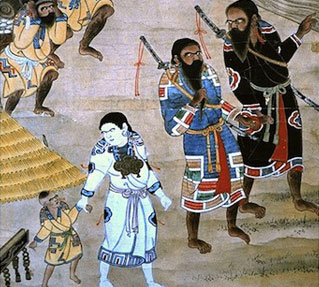Pages
|
The Fantasy of Japan in 150 Years of American-Japanese Interaction
In his recent book, The Great Wave, Christopher Benfey documents the nineteenth-century opening of Japan to the West and concludes that, "by the turn of the century, Japan had, for thirty years, been a fantasy world for American aesthetes." What Benfey means by this "fantasy world" is that the culture of traditional Japan that penetrated the hearts and minds of many nineteenth-century American intellectuals and artists opened up to them a world of refined beauty, subtle eroticism, and stoic Buddhist and Confucian philosophy during a period when life seemed increasingly threatened by materialism, shallowness, and vulgarity. American poets, artists, and scholars found in such traditional Japanese cultural artifacts as woodblock prints, haiku poetry, and the tea ceremony a welcome and inspiring alternative to Western culture.
This was true not only in America but in Europe as well. Japanese woodblock prints and screens are seen by many art historians as a major inspiration behind the Impressionist movement. As Virginia Spate and David Bromfield put it, "Japanese art was alien, an eruption from an unknown, dreamlike culture." Artists and collectors, who styled themselves Japonisants, would gather for dinners where they excitedly discussed how Japanese art offered them new and unconventional ways of seeing and painting. As the greatest Impressionist of them all, Claude Monet wrote, "Look at that flower with its petals turned back by the wind, is that not truth itself? . . . and here, near this woman by Hokusai, look at this bathing scene: look at these bodies, can you not feel their firmness? They are made of flesh, yet are described only by their outline. . . . These people have taught us to compose differently, there's no doubt about that."
"These people" inspired the English as well, who were fascinated both by the arts and what they knew of samurai culture. Perhaps the most brilliant (and funniest) response to Japonisme in England was Gilbert and Sullivan's 1885 operetta The Mikado. Technically set at a Japanese court, the playwrights used what they knew of Japanese conventions-beautiful young girls, the imperial throne, and the cult of the sword—to lampoon life and politics in Victorian England. The Japan craze inspired Oscar Wilde to have his protagonist in the novel The Decay of Lying muse, "The whole of Japan is a pure invention. If you desire to see a Japanese effect, you will not go to Tokyo, you will stay at home and steep yourself in the work of Japanese artists."
As fantasy, as inspiration, as an alternative to Western conventions, Japan loomed large in the late nineteenth-century imagination. Let us fast-forward one hundred years or so to 2002 when Douglas McGray published a memorable article for the journal Foreign Policy entitled "Japan's Gross National Cool." In it he asserts that Japan, despite recent economic problems, had become a "cultural superpower" whose cultural artifacts have increasingly become icons of "coolness" for young people around the world, including young Americans. At first glance, the "culture" to which McGray refers seems a far cry from that of nineteenth-century Japan. Instead, the world that McGray's article offers up is one of pop culture: Hello Kitty, animation (anime), comic books (manga), fashion design, and J-pop music. Not a tea ceremony or a Shintō shrine in sight!
There are both similarities and differences in what might be described as the "next wave" of American and Japanese cultural interactions. In many ways, Japan continues to be seen as a "fantasy world" although, as we all know, it is a real place afflicted with all the problems that beset the modern world. Furthermore, this fantasy world, especially in terms of the cultural products of manga and anime, offers more than simply an artistic oasis. While Japanese culture is having an intense impact on the visual arts in the West, the values that accompany anime and manga are also having an effect.
Pages
|











